
MACROECONOMICS OF UNBALANCED GROWTH: THE ANATOMY OF URBAN CRISIS* By WILLIAM I.BAUMOL There are some economic forces so powerful that they constantly break through all barriers erected for their sur ample,are the forces of supply and demand which haver medieval efforts to abolish t sted alik and co mpts to contro at I belie the futur ored the past and seems likely to stamp its characteron .It helps us to understand the prospective roles of a wide variety of economic services:municipal government,education,the per- forming arts,restaurants,and leisure time activity.I will ar gue that inherent in the technological structure of each of these acttesr forces working almost unavoidably for p sive and cumulative in creases in the real costs incurred in s ing them As a c equence. efforts to offset these cost in may succeed temporar- in the merely palliatives which can have no significant on th erlying trends. The justification of a macroeconomic model should reside primarily in its ability to provide insights into the workings of observed phenome Its aggregation of diverse variables usually deny it the elega nce and the rigor that are provided by microeconomic analy sis at its he models have succeeded in exp plaining the structu and in offerin guidance for policy egre far eluded th ore pa stak des at has so th e trad of economic analysis.This article hopes to fol- 1t1 the structure of its basic model is rudimentary. Yet it can perhaps shed some light on a variety of economic problems of our generation. 1.Premises Our model will proceed on several assumptions,only really essential.This basic premi not entirely arbitrarily, s that ecor activities can, gressive o two types:technologically pro activities in novations,capi tal accumulation.and economies of large scale all make for a cumulative rise in output per ◆The author i Ford Found ants 1am rming arts c every cas the data bave doc support Copyright2001 All Rights Reserved
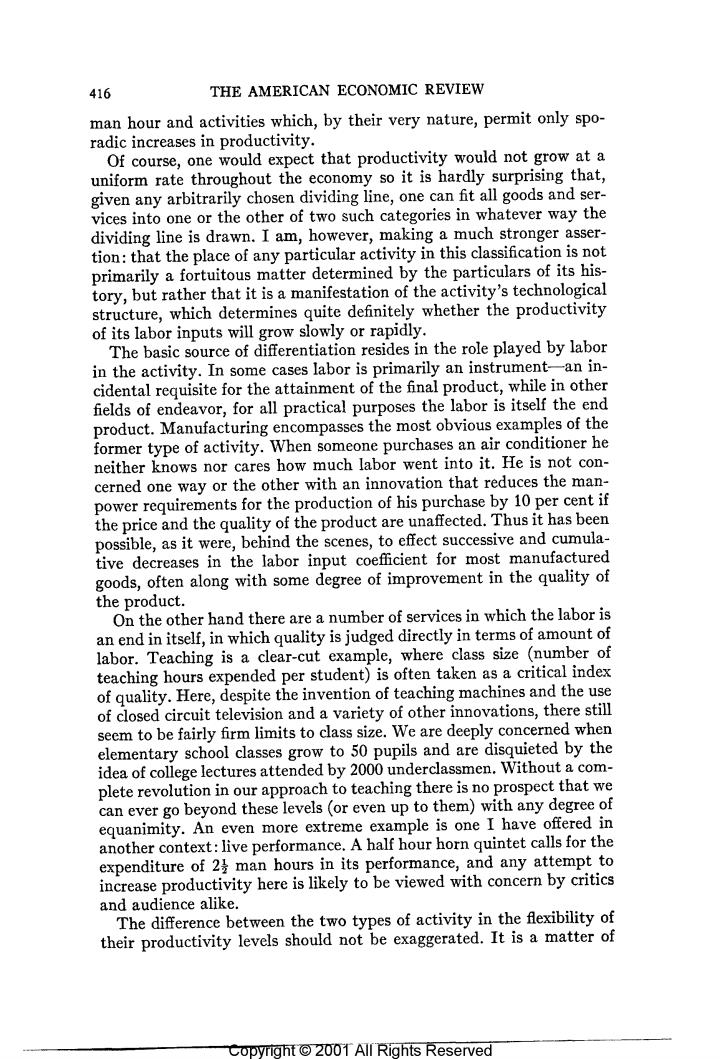
416 THE AMERICAN ECONOMIC REVIEW man hour and activities which,by their very nature,permit only spo- radic increases in productivity. one would expect that productivity would not grow at a uniform rate thro ghout the economy so it is hardly surprising that, given any arbitra chosen line,one can fit all goods and ser- two such cat gories in whatever way the dividing line is drawn.I am,however,making a that theplace ofny rcs is not primarily a fortuitous matter determined by the particulars ory butather thatitsfestation of theacti t which determines quite definitely whether the productivity of its lab por inputs willg w slowly or rapidlv. The basic ce of d entiation resides in the role played by labor in the activity. nent-an in cidental requisite for the attainme of the while in other fields of endeavor,for all practical purposes the is itself the end product.Manufacturing encompasses the most obvious exam es of th former type of activity.When someone purchases an air conditioner h neither knows nor cares how much labor went into it.He is not con cerned o e way or the other with an innovation that reduces the man power requi nts for the production of his purchase by 10 per cent if the price and the qu 4 f th e product are unaffected.Thus it has been Dossible.as it were the scenes,to effect su uccessive and cumula- tive decreases in the labor input coe anufactured goods,often along with some degree of improvement in ality the product. On the other hand there are a number of services in which the labor is nd in itself in which quality is iudged directly in terms of amount o ng is a clear-cut example,where class size (number of teaching hours expe nded r student)is often taken as a critical index of quality.Here,de pite of teaching machines and the use of closed circuit televi on and a a variety c othe, nnovations,there still seem to be fairly firm limits to class size.W are ed wher elementary school classes grow to 50 pupils and are dis ed by the idea of college lectures attended by 2000 underclassmen.Withou plete revolution in our approach to teaching there is no prospect that we an eve r go beyond these levels(or even up to them)with any degree of other 巧少. An even more extreme example is one I have offered text.liv e performance.A half hour horn quintet calls for the 0 expenditure increase produ and audience alike. The difference between the two types of activity in the flexibility of their productivity levels should not be exaggerate ed.It is a matter of
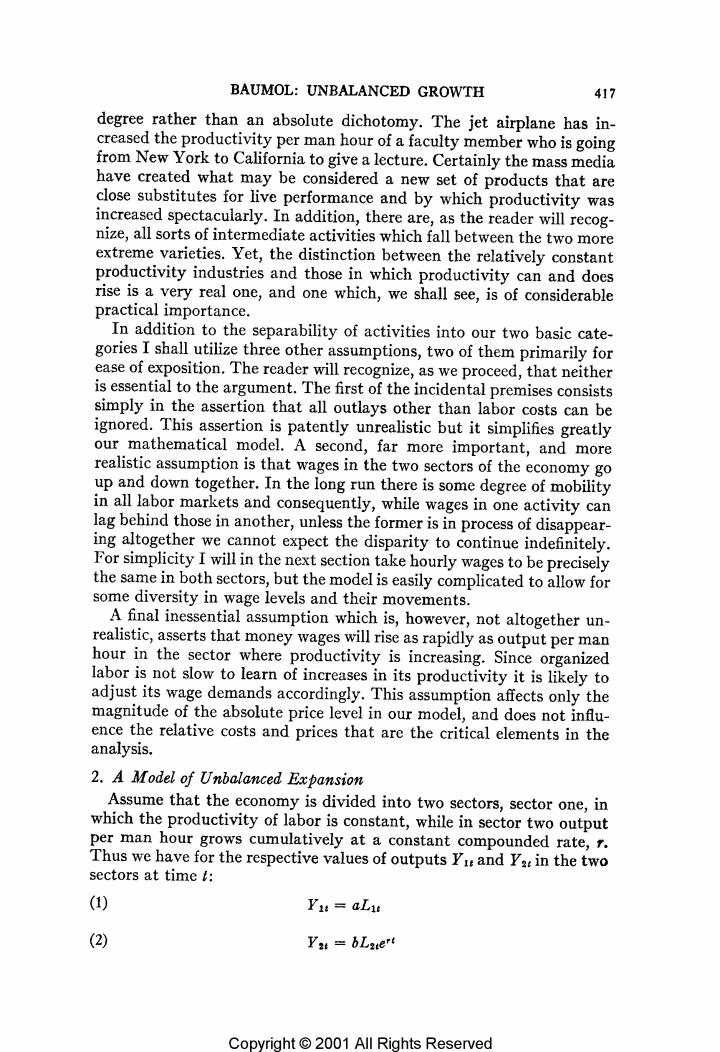
BAUMOL:UNBALANCED GROWTH 417 degree rather than an absolute dichotomy. The jet airplane has in- yper man hour of a faculty member who is going California to give a lecture.Certainly the mass media have created what may be considered a new set of products that are close substitutes for live performance and by which productivity was increased spectacularly.In addition,there are,as the reader will rec nize,all sorts of intermediate activities which fall bety cog the extreme varieties.Yet,the distinction betw ween the two more productivity industries and those in latively constant h productivity canand does ,and one which,we,of coniderable pr actical importance. In add ition to the separability of activities into our two basic cate- gories I shall utilize three other assumptions,two of them primarily for ease of exposition.The reader will recognize,as we proceed,that neithe is essential to the argument.The first of the incide ys other emise simply in the assertion that all outla consi or ignored.This assertic costs can n ie tently unr d。 c but it simplifies greatly mati A second,far more important.and more assumption is that wages in the two sectors of the economy go up an down together.In the long run there is some degree of mobility in all labor markets and consequently,while wages in one activity can lag behind those in another,unless the former is in process of dis ing altogether we cannot expect the disparity to contin For simplicity I will in the next se tion tak the same in both urly wages to be precisely sectors but the n odel is easily complicated to allow for wage levels and their movements. A final inessential assumption which is,however,not altogether un- realistic,asserts that money wages will rise as rapidly as output per man hour in the sector where productivity is increasing. Since organized labor is not slow to learn of increases in its productivity it is likely to adiust its wage demands according ly.This assu mption ects onl th magnitude of the absolute ice and does not influ- ence the relativ cost l in our model, s and prices that are the critical elements in the analysis. 2.A Model of Unbalanced Expansion Assume that the economy is divided into ty which the productivity of lab sectors,sector one,in constant,while in sector two output per man hour Thus we ha s cumulati at a constant compounded rate.r. ve for the respective valucs of outputs and in the two sectors at time: (1) Yu=aLu ® Ya =bLztert Copyright2001 All Rights Reserved
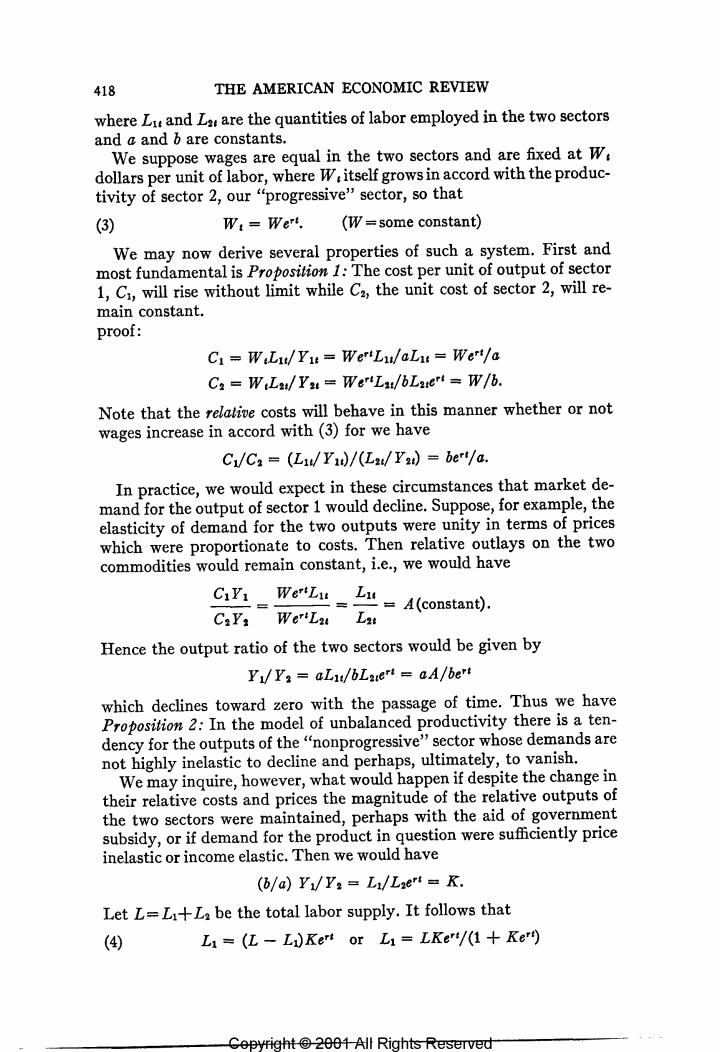
418 THE AMERICAN ECONOMIC REVIEW where L and La are the quantities of labor employed in the two sectors and a and b are constants. We suppose wages are equal in the two sectors and are fixed at We dollars pe unit of labor,where W:itself grows in accord with the produc- tivity of sector 2,our"progressive"sector,so that Wi=We". (W=some constant) We may now derive several properties of such a system.First and most fundamental is Proposition 1:The cost per unit of output 1,Ci,will rise without limit while Ca,the unit cost of sector 2,will re- main constant. proof: C1=WiLu/Yu=We"Lu/aLu Wer!/a Ca=WLa/Y=We"La/bLate"!=W/b. Note that the relative costs will behave in this manner whether or not wages increase in accord with (3)for we have Cv/Ca=(L/Y)/(La/Y)=be"!/a. In practice,we would expect in these circumstances that market de mand for the output of sector 1 would decline.Suppose,for example,the elasticity of demand for the two outputs were unity in terms of prices which we re prop ortio nate to costs.Then relative outlays on the two commodities would remain constant,i.e,we would have c_-0 Lu(constant). Hence the output ratio of the two sectors would be given by Y1/Y:=aLut/bLate"t aA/bert which declines toward zero with the passage of time.Thus we have Proposition 2:In the model of unbalanced productivity there is a ten- dency to or the ts of the"nonprogressive"sector whose demands are c to decline perha ultimately,to vanish. We may inquire,however,wh t wo n if despite the change in their relative costs and prices th e magnitud elative outputs of the two sectors were maintained,perhaps with the aid of nment bymndothe prodcteruntprice inelastic or income elastic.Then we would have (b/a)Y1/Y:=L/Le"t K. LetL=L+La be the total labor supply.It follows that (④) L=(L-L)Ke"t or L LKe"t/(1+Ke") epyright2001-All Rights Reserved

BAUMOL:UNBALANCED GROWTH 419 and (5) L:=L-L:=L/(1+Ke" 女22 zero.Thus of the outputs of the two sectors is held constant, more and more of the total labor force must be transferred to the non- progressive sector and the amount of labor in the other sector will tend to approach zero. Finally,we may note what happens to the output in the economy if the o mitted to change.Wen utput aouytake as an index of output a weighted aver- e two sectors: I=BiY1+BaYa BaL+BabLaert so that by (4)and (5) I=L(KBa+B2b)e"t/(1+Ke")Re"!/(1+Ke") where R=L(KB1a+B26). Therefore dI/dt =R[re"t(1+Ke")-Kreart]/(1+Ke) rRe"t/(1+Ke)2. As a result,the percentage rate of growth of output will be (dI/dt)/I=r/(1+Ke) which declines asymptotically.We have,then, arrived at Proposition 4:An dedinimg at achieve balanced growth in a relativ to ductiv the rate of growth of the labor force.In particular,if pro- ity in o sector and the total labor force remain constant the growth rate of the economy will asymptotically approach zero. 3.Discussion of the Propositions The logic of the entire analysis can be restated rather simply in intui tive terms.If productivity pe man hot es cumulativelyi In one sector relative to its rate of gro wth elsewher the ec commensurately in all a ,the omy,while wages rise elative cost s in the nonprogressive sectors must inevitably ,and these costs rise cmatieynd ithout limit For while in the progressive sector productivity increases will serve as an offset to rising wages,this offsetmust be maller in the Copyright2001 All Rights Reserved

420 THE AMERICAN ECONOMIC REVIEW nonprogressive sectors.For example (ignoring nonwage costs)if wages and productivity in the progressive sector both go up 2 per cent per year,costs there will not rise at all.On the other hand,if in the nonpro- gre ssive sector roductivity is constant,every rise in w ge must vield a correspo ddition o costs a two per ce cumu e in ages m ns that,year in year out costs must be two per cent above those of the preceding year.Thus,the very progress of the technologi cally progressive sectors inevitably adds to the costs of the technologi- cally unchanging sectors of the economy,unless somehow the labor mar- kets in these areas can be sealed off and wages held absolutely constant, a most unlikely possiblity. We see then that costs in many sectors of the ecor will rise relent- lessly nd will do so rea are for all pra tical yo. nd the control of those involved.The consequ uence the outpu of these sectors may in some cases tend to be driven from the market.I their relative outputs are maintained,an ever increasing proportion of the labor force must be channeled into these activities and the rate of growth of the economy must be slowed correspondingly. 4.Some Applications' These observations can be used at once to explain a number of ob served phenomena.For example,there is evidence that an ever increas- ing portion of the nation's labor force has been going into retailing and that a rising portion of the cost of commodities is accounted for by out- lays on marketing.Now there have been several pronounced changes in the technology of marketing in recent decades: er. market.and selfservice,the sup ing ha all in ed the r of the r etailing personn el.But ulti in the nature of a service and it does not all w for constant and cum tive increases in productivity through capital accumulation,innovation, or economies of large-scale operation.Hence it is neither mismanage ment nor lack of ingenuity that accounts for the relatively constant productivity of this sector.Since some sort of marketing effort is an inescapable element in economic activity,demand for this service is quite income elastic.Our model tells us ect in this cas cumulatively ing osts relative to those of other mic activi- ties,and the ab rption ev ng propor 's re 00 by t pre ely wha see en observed Higher education is another activity the deman Ior wh se product seems to be relatively income elastic and price inelastic.Higher tuition charges undoubtedly impose serious hardships on lower-income stu- Some of the ideas in this section arose out of discussions with Eugene Beem of Sperry opyright2001 AIf Rig nts Reserve
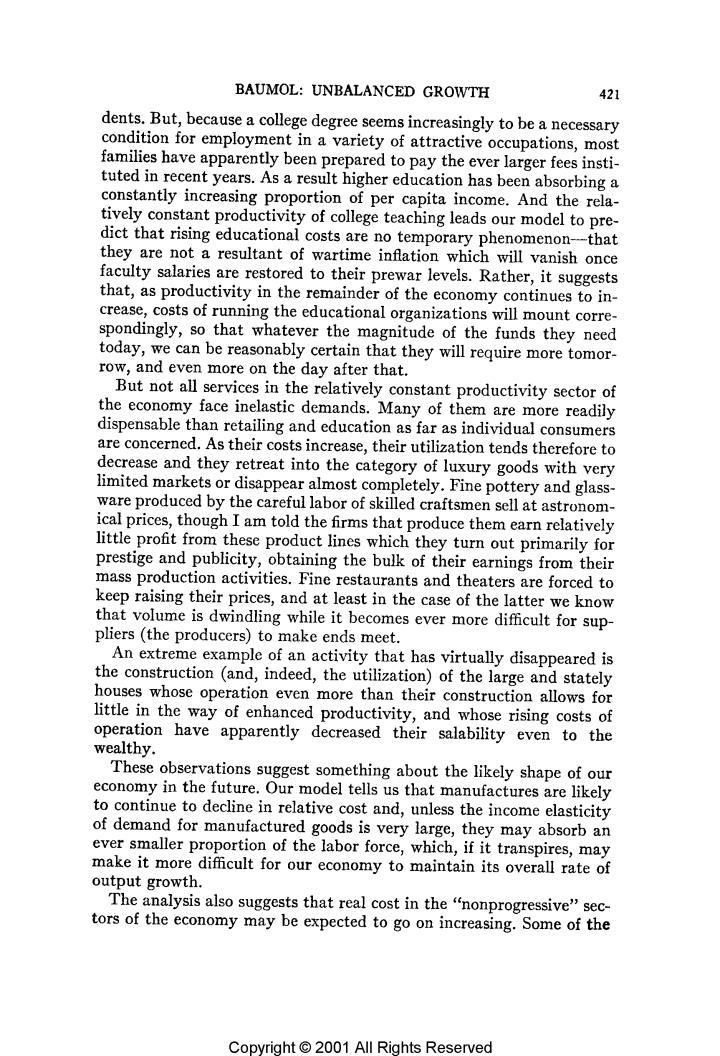
BAUMOL:UNBALANCED GROWTH 421 dents.But,because a college degree seems increasingly to be a necessary condition for employr families have ent in a variety of attractive occupations,most apparen tuted in ly been prepared to pay the ever larger fees insti- nt years.As a result higher education has been absorbing a nstantly increasing proportion of per capita income.And the rela- vely constant productivity of college teaching leads our model to pr dict that rising educational costs are no temporary phenom they are not a resultant of wartime inflation nish onc faculty salaries are restored to their t r ar levels. that,as productivity in the remainder Rather,it suggests omy continues to in- crease octe of f the ec that ational organizations will mount corre. tever the magnitude of the funds they need e can be reasonably certain that they will require more tomor- row,and even more on the day after that. But not all services in the relatively constant productivity sector of the economy face inelastic demands.Many of the dispensable than retailing and education as ar onsumers are concerned.As their costs in decrease and they their utilization tends therefore to treat int limited ma ket the category of luxury goods with very or are prod disappear almost completely.Fine pottery and glass. the care ul labor of skilled craftsmen sell at astronom. prices,thoug I am told the firms that produce them earn relatively little profit from these product lines which they turn out primarily fo prestige and publicity,obtaining the bulk of their the mass production activities.Fine restau nd theat are fo ed to keep raising their prices,and at least in the case of the te we know that volume is dwindlir while it pliers(the produ becomes ever more difficult for sup- ers to make ends s meet An extre examp f an activity that has virtually disappeared is the construction (and,indeed,the utilization)of the large and stately ses whose operation even more than their construction allows for little in the way of enhanced productivity,and whose rising operation have apparently dec reased their salability even to the wealthy. economy in the fut 38e ething about the likely shape of our ur Our n to continu decl del tells us that manufactures are likely of den in relative cost and,unless the income elasticity d for manufactured goods is very large,they may absorb an ever smaller proportion of the labor force,which,if it transpires,may make it more difficult for our economy to maintain its overall rate of output growth. The analysis also suggests that real cost in the"n tors of the economy may be expected to go on increasing.S essive" se ne of the Copyright2001 All Rights Reserved

422 THE AMERICAN ECONOMIC REVIEW services involved-those whose demands are inelastic may continue viable on the free market.Some,like the theater,may be forced to leave this market and may have to depend on voluntary public support for their survival.Our ho pitals,our institutions of private education and a variety of other nonprofit organizations have already long survived on this basis,and can continue to gnitude of contributions keeps up with costs.Some activities will isappea reat to a mascale of operation catering primarily to a luxury trade.Thisa may be in store for restaurants offering true haule cuisi and it is al- ready the case for fine hand-worked furniture and for clothes made to e.Some activities,perhaps many of the preceding among them, all in singly into the hands of the amateurs who already play a considerable role in theatrical and orchestral performances,in gastron- omy.in crafts such as woodworking and 00 Finally.there is a considerable segment of nonprogressi ive activity that is der tax support.Some of the problems that go with this posi will be considered in the remainder of this paper. In all the observations of this section there is one implicit underlying anger that should not esape the reader:the inherent threatto quality d teur activ vity has its virtues,as an educational device,as a good use for leisure tir But in a variety of fields it offers a highly imperfect substitute for the hig ghly po plied by the professional. Jnbalanc pro growth then threatens to destroy many of the activities that do so much to en ich our existence,and to give others over into the han ds of the amateu Th are dangers which many of us may feel should not be ignored or taken lightly. 5.On the Financial Problem of the Citie One of the majo the cities are at- at least the core of the metropolis is plagued by a variety of ills includi .spre g blight as entire neighborhoods deteriorate,increasing pollution ening traffic,critical educational problems,and,above al ounting fiscal pressures.The financial troubles are perhaps central use without adequate funds one cannot hope to mount attack on the other difficulties.More than one reform ermined to undertakea radical progamto ealihich hdis 14 and found himself baffled and stymied by d to be ha cit whose source appeared to have no rea exp lanation.There seems in these cases tobe no way to accountfo 80 th in the city's financial needs-for the fact that a municipal budget far above that opyright 2001 All Rights Reserved
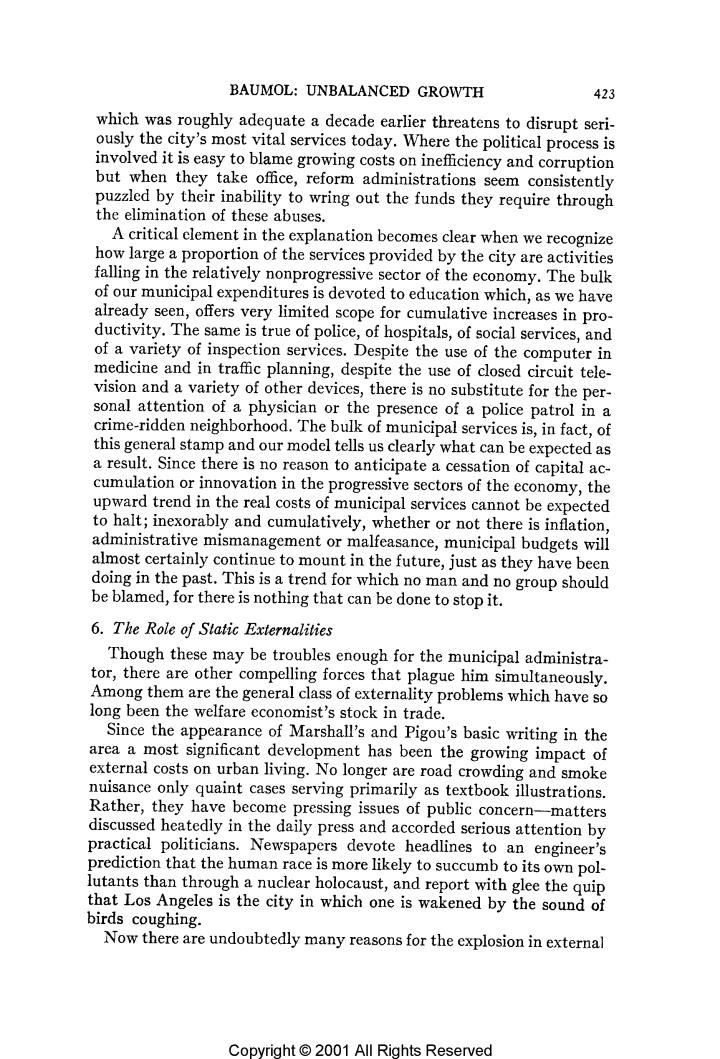
BAUMOL:UNBALANCED GROWTH 423 which was roughly adequate a decade earlier threatens to disrupt seri ously the city's most vital services today. Where t the political process is involved it is but wher easy to blame growing cos ts on ine fficiency and corruption 41 offce,reform adr inistrations seem consistently zled by their inability to wring out the funds they require through theofth A critical element in the explanation becomes clear when we recog how large a proportion of the services provided by the city are gnize ector of the my offer ed to educat hich,as we have limited s 0P r cumulative increases in pro The s e true of police,of hospitals,of social services,and ariety inspection services.Despite the use of the computer in dicine and in traffic planning,despite the use of closed circuit tele. vision and a variety of other devices,there is no substitute for the sonal attention of a physician or the presence of a police natrol in crime-ridden neighborhood.The bulk of municipal se this general stamp and our model tells us clearly s,in fac what n bo expe d as a result.since there is no ason to antici on of capital ac. or inn the progre pate a cessati ve sectors of the economy,the ward trend the n costs municipal services cannot be expected t in orab ly and cumulatively,whether or not there is inflatior administrative mismanagement or malfeasance,municipal budgets will almost certainly continue to mount in the future,just as they have be doing in the past.This is a trend for which no man and no group should be blamed,for there is nothing that can be done to stop it. 6.The Role of Static Externalities Though these may be troubles enough for the municipal administra- are oth compell g forces that plague him simultaneously. are the general class of externality problems which have so e thebale iting in the area a most significant development has been the growing in external costs on urban living.No longer are road smol nuisance only quaint cases serving primaril ook illustrations Rather,they have become -matters discussed heatedly practical in the daily press and d serious attention by P headlines to an engineer's pr dic t the Newspapers devote uman race more likely to succumb to its own pol. than through a nuclear holocaust,and report with glee the quip ethe city in which one is wakened birds coughing. Now there are undoubtedly many reasons for the explosion in external Copyright2001 All Rights Reserved
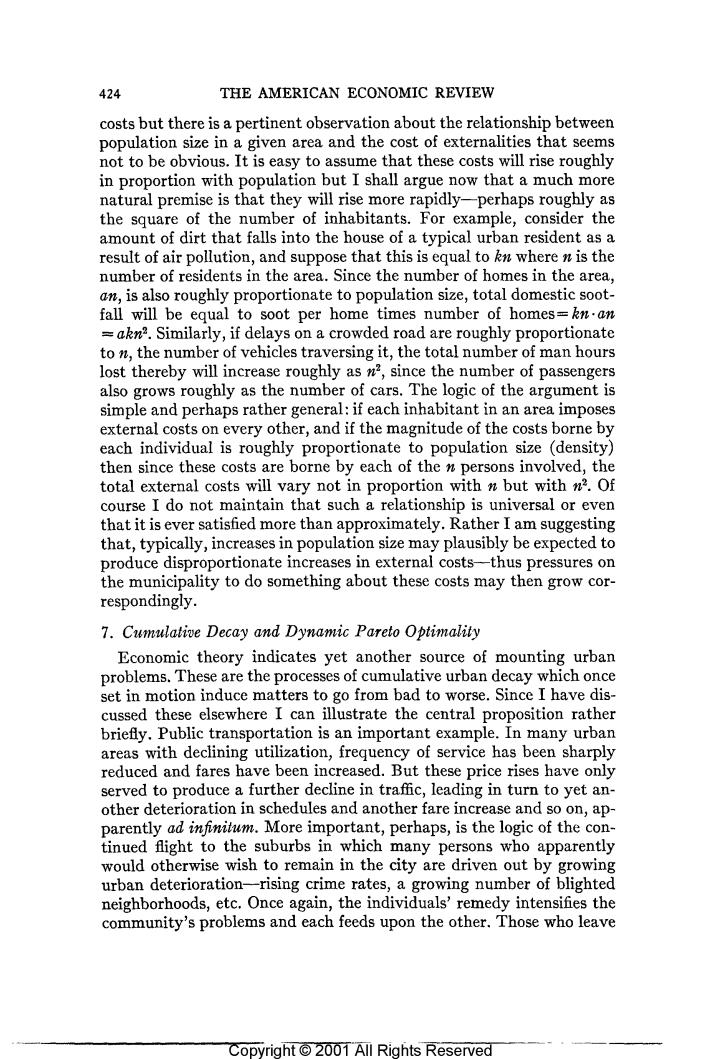
424 THE AMERICAN ECONOMIC REVIEW costs but there is a pertinent observation about the relationship between a given area and the cost of externalities that seems s Tt i that thes costs will rise r in proportio t I shall argu now that a much natural premise rise more rapidly-perhaps roughly as the square of the number of inhabitants.For exam ple.consider the amount of dirt that falls into the house of a typical urban resident as a result of air pollution,and suppose that this is equal to n where is the number of residents in the area.Since the number of homes in the area, an,is also roughly proportionate to population size,total domestic soot- fall will be e soot per home times number of homes=kat akn2.Similarly if dela cro ded ad a 01 0, the nun of vehicles tra versing it,the to al nun an hour lost thereby will increase roughly as n,since the numbe r of passengers also grows roughly as the number of cars.The logic of the argument is simple and perhaps rather general:if each inhabitant in an area imposes external costs on every other,and if the magnitude of the costs borne by each individual is roughly proportionate to population size (density then since these costs are borne by each of the n persons involved,the total e rnal costs will var not in wvith a but with O eI do no ntain t such a re iversal or that it is ever satisfied more than approximately. am sugge that,typically,increases in population size may plausibly be expected to produce disproportionate increases in external costs-thus pressures on the municipality to do something about these costs may then grow cor- respondingly. 7.Cumulative Decay and Dynamic Pareto Optimalily Economic theory indicates yet another source of mounting urban problem are the of cu e urban set in motion ind ce ma ters t 0 rom Ito wo se.Sinc I have cussed these elsewhere can illustrate the central proposition rather briefly.Public transportation is an important example.In many urban areas with declining utilization,frequency of service has been sharply reduced and fares have been increased.But these price rises have only served to produce a further decline in traffic,leading in turn to yet an- other deterioration in schedules and another fare increase and so on,ap. ntly ad.More important.perhaps.is the logic of the con sons who a would ish to Apparently remain in the city ar drive deter rising c ng nu neighborhoods,etc.Once agai the e individu Is're community's problems and each feeds upon the other.Those who leave opyright 2001 All Rights Reserved